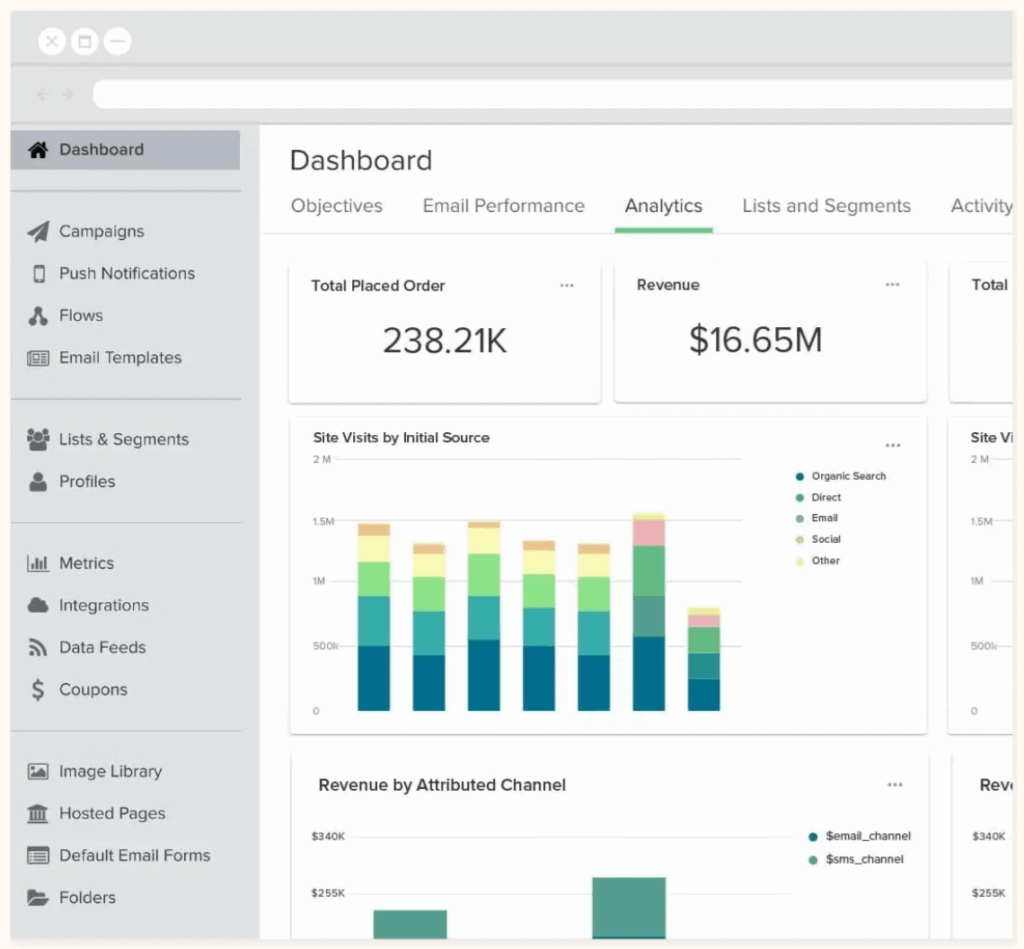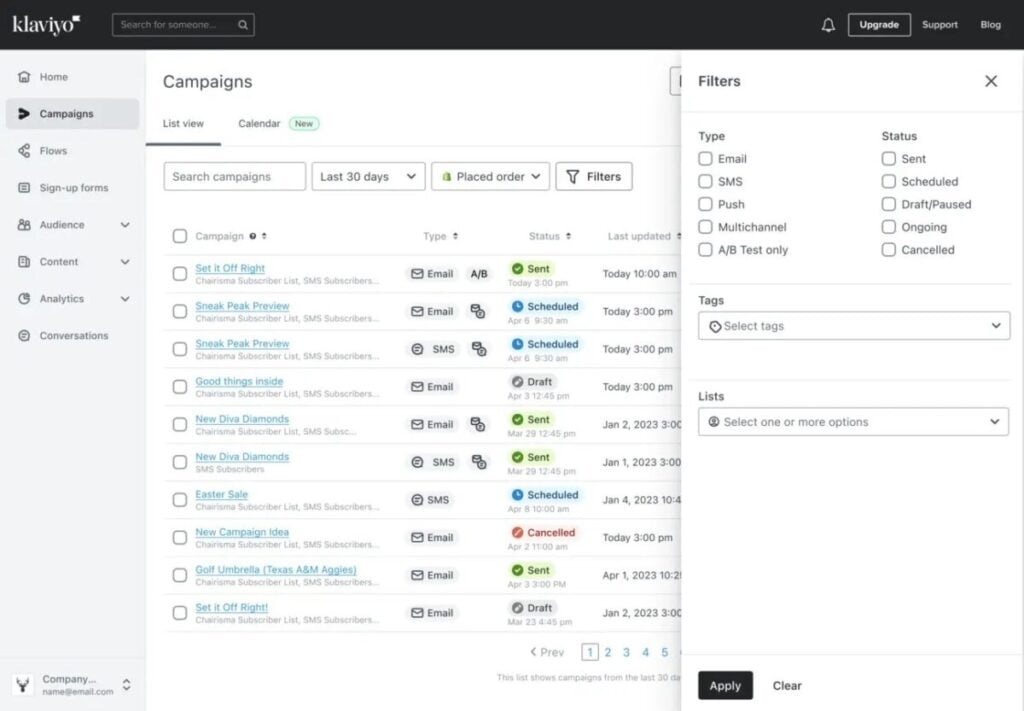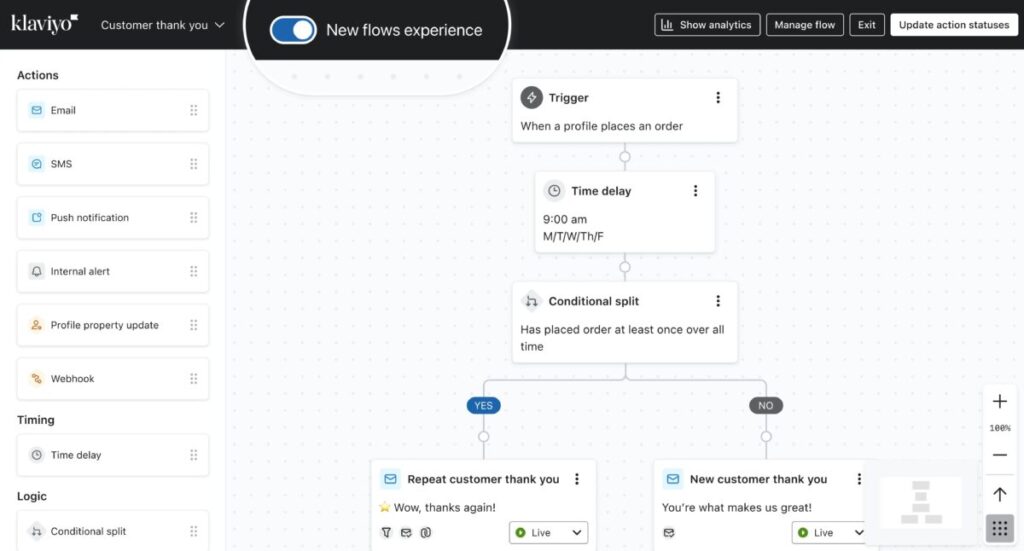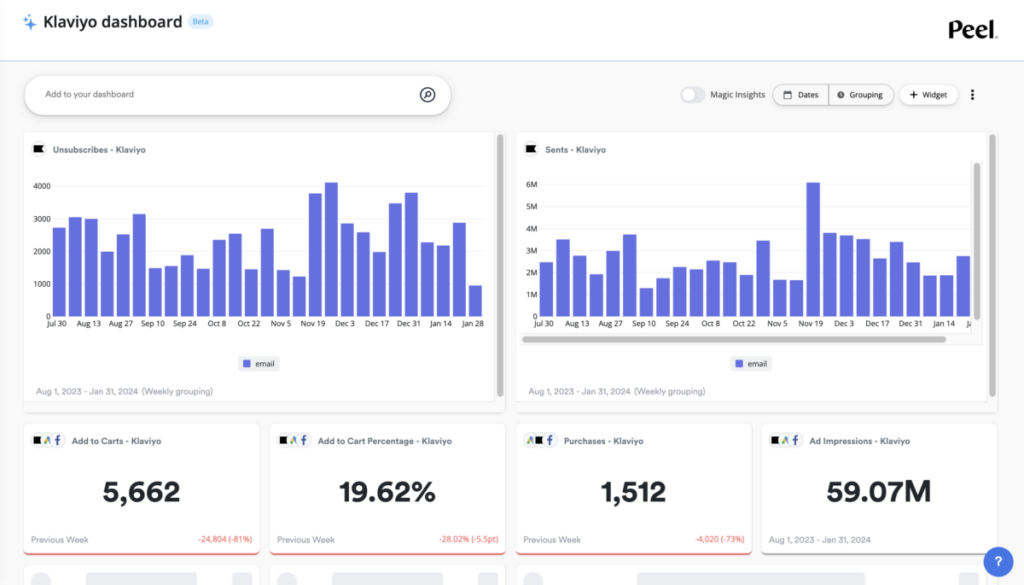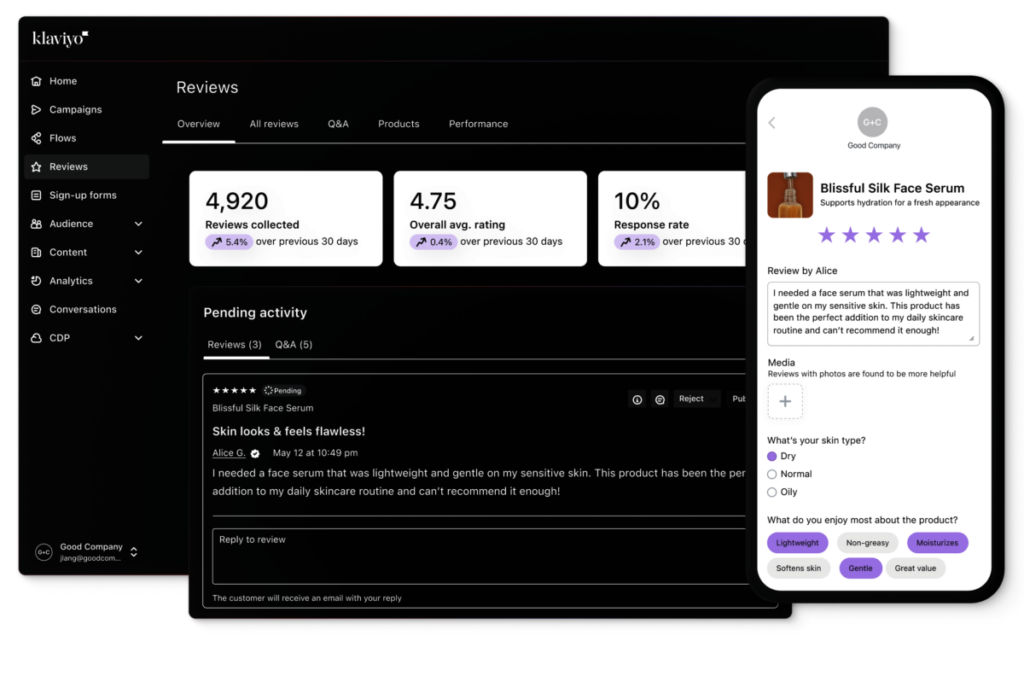
Software rarely earns longevity on momentum alone. Klaviyo – founded in 2012, IPO in 2023, has done it the hard way: by centering first-party data and obsessing over ecommerce outcomes. That focus shows up everywhere, from its Shopify-tight integrations to the way predictive analytics come pre-wired for marketers who’d rather build segments than models. As of 2025, Klaviyo reports 176,000+ paying customers, 7B+ customer profiles, and billions of events processed daily – numbers that justify calling it an “AI-first B2C CRM,” not just “an email tool.”
Why it’s resonating with ecommerce teams
Where many ESPs bolt data on top of messaging, Klaviyo flips the stack: the Klaviyo Data Platform sits at the core, unifying identities and events across your store, site, and marketing channels. That makes everyday marketer tasks—“who added to cart but didn’t purchase in the last 7 days?” or “which VIPs are likely to churn next month?”—feel native instead of hacked-together. Predictive dashboards expose CLV, churn risk, and expected next order without a separate data science sprint, and those predictions are available anywhere you’d build a segment, flow, or campaign.
The result is one of Klaviyo’s signature experiences: personalization at scale that’s grounded in real-time behavior. You’ll feel it when building an abandoned-cart series that branches by “purchase likelihood,” or when swapping a blanket broadcast for a channel-affinity journey that nudges SMS-first shoppers by text and email-centric buyers by—well—email. (That “meet people where they convert” mentality shows up in Klaviyo case studies, not just marketing pages.)
A guided, “marketer-in-the-loop” build flow
If you’ve ever wired complex automations, you’ll appreciate how Klaviyo keeps power visible but approachable. Campaign setup runs step-by-step (audience → template → tracking → schedule), while the visual flow builder keeps conditions and splits readable as programs grow. For teams that need to get live yesterday, Klaviyo now adds K:AI Marketing Agent—an embedded agent that scans your site and drafts on-brand campaigns, signup forms, and flows you can approve and launch. It’s more “co-pilot who builds the skeleton” than “suggestion bot,” and it accelerates that painful first 80%.
Omnichannel without the sprawl
Klaviyo treats email, SMS, WhatsApp, and mobile push as channels on one canvas instead of separate products you wrestle into sync. That matters operationally (one place to manage consent, preferences, and frequency), financially (you aren’t paying three vendors to message the same person), and strategically (you can segment and automate across channels using a single profile graph). For Shopify merchants, the integration is so deep that Shopify itself elevates Klaviyo as its preferred or recommended email solution, and the App Store page underscores just how rich the two-way data sync is.
Scale, reliability, and the “enterprise without the overhead” feel
At volume, speed and stability are features. Klaviyo publishes hard numbers:
- ~2.5B daily events
- ~7.3B customer profiles
- 99.95% uptime
- 1.6B API calls/day
and these explain why bigger brands consolidate onto the platform rather than duct-tape a CDP to an ESP to an SMS point solution. The infrastructure is there, the segmentation engine is fast (see their engineering write-ups on ClickHouse), and deliverability tooling (domain auth, dedicated IPs, suppression management) is built in. Translation: growth doesn’t force a replatform.
Real outcomes, not just nicer emails
The case studies are unusually candid about money and time saved. Dollar Shave Club cites a 30%+ reduction in total cost of ownership after consolidating their CRM stack in Klaviyo, plus 60%+ faster campaign setup—the kind of efficiency win that compounds across a busy calendar. GourmetGiftBaskets.com reports 81× ROI after adding Klaviyo Marketing Analytics to sharpen RFM segmentation and cohort analysis, with double-digit revenue-per-recipient lifts month-over-month. These aren’t edge cases; they’re emblematic of what a unified data + messaging stack produces.
The Details (what it’s like to actually use it)
Dashboard & data model
You start in a hub that surfaces what matters: audience growth, flow/campaign performance, and ecommerce journey checkpoints (add-to-cart, repeat purchase, etc.) when you’ve connected your store. Because Shopify/Plus, BigCommerce, and other storefronts sync natively, profiles populate themselves and keep updating as customers browse, buy, and churn. You can build segments from any mix of traits and behaviors: geography, last purchase date, product affinity, purchase likelihood, churn risk, loyalty tier, and more.
Campaigns
A guided composer walks you through audience selection, guardrails, and content. You can start from proven templates or have K:AI lay down a launch-ready plan that matches your brand voice (the agent reads your site for style and product context). For teams that live on deadlines, this feels like adding a production assistant who never sleeps—and who’s been trained on your data.
Flows (automations)
This is Klaviyo’s superpower. You’ll find the usual suspects—welcome, browse abandonment, cart abandonment, post-purchase—along with ecommerce-specific branches like back-in-stock and “expected next order date.” The visual builder keeps splits legible, experiments easy (A/B, holdouts, conditional content), and channel-specific steps (send SMS vs email vs WhatsApp) on one timeline. Over time, predictive fields unlock smarter decisioning: delaying a replenishment nudge until a customer is within their reorder window, for example.
Analytics & optimization
Out of the box, you’ll see revenue attribution, revenue per recipient, cohort retention, and flow/campaign performance. The Marketing Analytics add-on goes deeper with RFM segmentation and cohort analysis—helpful for diagnosing “who buys again and when” by product line or channel. Engineering-minded teams will like the live profile object and event stream; ops teams will like that everything is exportable or warehouse-syncable via the Advanced Data Platform add-on when you outgrow CSVs.
Service, Reviews, & On-site
Klaviyo’s steady march beyond “marketing only” matters for lifecycle teams. Customer Agent (AI support), Helpdesk, Customer Hub, and Reviews live alongside Marketing, all feeding the same profile and segmentation fabric. The practical upside: a service ticket can trigger a win-back flow; a five-star review can trigger a referral offer; an on-site account hub can personalize offers with the same brain your email program uses.
Integrations (and why they matter)
If you’ve been burned by brittle connectors, the 350+ native integrations will feel like air conditioning in August. The Shopify connection in particular isn’t just “orders in, emails out”—it’s two-way, frequent-sync, profile-level data that powers segmentation and real-time triggers without manual plumbing. You’ll also find connectors to subscriptions (Recharge), ad platforms (Meta/Google), helpdesks, loyalty tools, and data warehouses—enough to make Klaviyo the system of action across your stack.
TL;DR
Klaviyo is more than an email tool; it’s a B2C CRM that turns ecommerce data into growth. The combination of unified profiles, predictive analytics, and AI-assisted build flows gives teams the power to personalize at scale without waiting on a data engineering queue. If your revenue strategy leans heavily on owned channels, it’s hard to find a faster path from “hooked up” to “ROI.”
The verdict
If you’re an ecommerce brand that believes customer data should power every interaction, Klaviyo is the shortest path from that belief to measurable revenue. The platform’s center of gravity is segmentation and predictive insight; its edge is how little heavy lifting it takes to operationalize them across channels. The new K:AI agents make setup and iteration faster without removing marketers from the loop, and the product’s expansion into service (Customer Agent, Helpdesk) plus on-site (Customer Hub) and social proof (Reviews) turns the CRM into a full lifecycle engine.
There are caveats—budget for growth, mind your active profiles, and be intentional about which add-ons you truly need—but those are high-class problems. For most DTC teams, Klaviyo will feel like graduating from tool sprawl to a durable, data-smart system you can scale.
Pricing / month
1. Free: For up to 250 active profiles and 500 monthly email sends; includes 150 SMS/MMS credits, basic support, and access to the AI Marketing Agent. Good for testing and small lists.
2. Email: Starting at $45/mo with 15,000 emails/month included (price scales with active profiles). If you plan to mail large lists often, budget for upgrades as your active profiles grow.
3. Email + Mobile: Starting at $60/mo with 15,000 emails + 1,250 messaging credits (US pricing shown on site). Helpful if you want SMS/WhatsApp orchestrated in the same flows.
4. Add-ons: Marketing Analytics (advanced RFM/cohorts), Advanced Data Platform (warehouse sync, no-code transforms), Reviews, Helpdesk, Customer Hub—priced based on profiles, orders, or ticket volumes.
Two important notes on budgeting:
- Active profiles drive your tier, not just monthly sends; prune or suppress disengaged contacts to avoid auto-upgrades.
- Consolidation offsets add-on costs: some brands reduce TCO materially by retiring a separate CDP, ESP, and SMS tool in favor of Klaviyo’s unified stack (see Dollar Shave Club).
Date founded
2012Located
Boston, Massachusetts, USACompany size
1,500+Features
Email Marketing
Lead Scoring
Segmentation
Email Marketing
Marketing Automation Integration
SMS Marketing
AB Testing
Lead funnels
Analytics & Reporting
AI enabled automated flows
SMS + email in one workflow
Reviews
Klavyio Ratings
-
Features
-
Ease of Use
-
Reporting
-
Integrations

